
Chato

Naiche

Mangas

Chihuahua

Nana
Other notable Apache leaders
Here is a list of other notable Chiricahua Apache leaders, excluding Cochise, Geronimo, and Lozen, who played significant roles in the tribe’s history, particularly during the Apache Wars and their resistance to American and Mexican encroachment:
**Mangas Coloradas (c. 1793–1863)** - **Role**: A prominent leader of the Mimbreño band of the Chiricahua Apache, Mangas Coloradas was a key figure in the early Apache Wars. He allied with Cochise, his son-in-law, to resist settlers and military forces in Arizona, New Mexico, and northern Mexico. - **Notable Actions**: Led raids against Mexican settlements in Sonora and Chihuahua, and later against American miners and settlers. He was a central figure in the 1861 Bascom Affair, which escalated hostilities. Mangas was killed in 1863 by U.S. soldiers under a flag of truce, an act that fueled further Apache resistance. - **Significance**: Known for his strategic leadership and efforts to unite Apache bands against external threats.
**Victorio (c. 1825–1880)** - **Role**: A leader of the Warm Springs (Chihenne) band of the Chiricahua Apache, Victorio was a skilled warrior and tactician who led resistance efforts after Mangas Coloradas’ death. - **Notable Actions**: Conducted raids in New Mexico, Texas, and northern Mexico, particularly in the late 1870s, to protect his people from forced relocation to the San Carlos Reservation. He led the Victorio War (1879–1880), a series of battles against U.S. and Mexican forces, before being killed at the Battle of Tres Castillos in 1880. - **Significance**: Renowned for his guerrilla tactics and ability to evade capture in harsh desert terrain.
**Juh (c. 1825–1883)** - **Role**: A leader of the Nednhi band of the Chiricahua Apache, primarily based in the Sierra Madre of northern Mexico. - **Notable Actions**: Allied with Geronimo and other leaders in raids across the U.S.-Mexico border. Juh was known for his strategic retreats into Mexico’s rugged mountains, making him difficult to pursue. He participated in major campaigns in the 1870s and early 1880s but died in 1883, likely from a fall while intoxicated. - **Significance**: His leadership in the Nednhi strongholds in Mexico provided a safe haven for Chiricahua warriors during conflicts.
**Chato (c. 1854–1934)** - **Role**: A Chiricahua leader who initially resisted U.S. forces but later served as a scout for the U.S. Army. - **Notable Actions**: Participated in raids alongside Geronimo in the early 1880s but surrendered in 1883 and worked with General George Crook to track down other Apache groups. After the Apache Wars, he was exiled to Fort Marion, Florida, and later lived on the Mescalero Reservation. - **Significance**: His complex legacy reflects the difficult choices faced by Apache leaders during the waning years of resistance.
**Naiche (c. 1857–1919)** - **Role**: The last hereditary chief of the Chokonen band of the Chiricahua Apache, son of Cochise, and a key leader during the final years of the Apache Wars. - **Notable Actions**: Led alongside Geronimo in the 1880s, participating in raids and resisting relocation to reservations. After surrendering with Geronimo in 1886, he was imprisoned in Florida and Alabama before being released to the Mescalero Reservation. - **Significance**: As Cochise’s son, Naiche carried forward the Chokonen leadership and was a symbol of Chiricahua continuity during exile.
**Chihuahua (c. 1822–1886) - **Background**: Chihuahua was a war chief of the Chokonen band of the Tsokanende (Chiricahua) Apache, known for his leadership during the Apache Wars in the 1870s and 1880s. He led raids in Arizona, New Mexico, and northern Mexico, resisting U.S. and Mexican forces. Chihuahua surrendered with Geronimo’s band in 1886 and was exiled to Fort Marion, Florida, as a prisoner of war.
After his surrender in 1886, he was part of the group of Chiricahua prisoners sent to Fort Marion, Florida, where group photos were taken. Some of these images may include Chihuahua, but individual identification is often uncertain.
Nana (c. 1805/1810?–1896) - **Background**: Nana was a war chief of the Warm Springs (Chihenne or Tchihende) band of the Chiricahua Apache, known for his leadership in the final resistance against U.S. domination. After Victorio’s death in 1880, Nana led survivors in raids across Texas, New Mexico, and northern Chihuahua, Mexico, despite being elderly and physically frail. He surrendered with Geronimo in 1886 and was held as a prisoner of war in Florida and later Fort Sill, Oklahoma.
As a leader active primarily in the 1870s and 1880s, Nana operated in remote areas, and photography was not common. Like Chihuahua, he was among the Chiricahua prisoners sent to Fort Marion in 1886, so he may appear in group photos from that period, but no individual portraits are documented.
These leaders, through their military strategies, diplomacy, and resilience, helped shape the Chiricahua Apache’s resistance to colonization and their efforts to preserve their way of life. Each played a distinct role in the complex dynamics of Apache survival in the 19th century.

Victorio